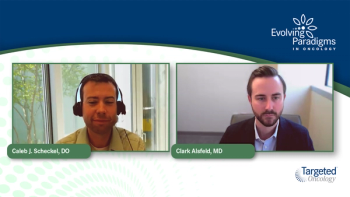
Case Presentation: A 76-Year-Old Man with Relapsed Diffuse Large B-Cell Lymphoma
Laurie Sehn, MD, presents the case of a 76-year-old man with relapsed/refractory diffuse large B-cell lymphoma.
Episodes in this series

Laurie Sehn, MD: I’m Laurie Sehn from BC Cancer in Vancouver, Canada. Today I’ll be presenting a case of a patient with relapsed/refractory diffuse large B-cell lymphoma [DLBCL]. This patient is very similar to many patients I see in my own clinic. It’s a 76-year-old man who presented with progressive fatigue, enlarged lymph nodes in his neck and groin, pruritus, and a decreased appetite. He had several comorbidities, including prediabetes, medically controlled hypertension, BPH [benign prostatic hyperplasia], and osteoporosis. On examination, he was found to have palpable cervical and inguinal lymphadenopathy, as well as splenomegaly. Overall, his ECOG performance status was 2.
He underwent a clinical work-up that included laboratory tests that identified a mild anemia with a hemoglobin of 9.9 g/dL. All of his other lab work was relatively normal. His LDH [lactate dehydrogenase] was normal. He had serologies for hepatitis B and C and HIV that were negative. He underwent an excisional biopsy of a lymph gland in the groin that confirmed a diffuse large B-cell lymphoma, GCB subtype.
He underwent an excisional biopsy of a lymph gland from the groin that confirmed a diffuse large B-cell lymphoma, and by IHC [immunohistochemistry] was demonstrated to be GCB subtype. FISH [fluorescence in situ hybridization] testing was done, which identified a rearrangement with BCL2, but there was no MYC or BCL6 rearrangement, so he was not confirmed to have a double- or triple-hit lymphoma.
Flow cytometry demonstrated all the notable B-cell markers, including CD19 and CD20. Staging tests included a whole-body PET [positron emission tomography]/CT scan, which confirmed lymphadenopathy both above and below the diaphragm, mainly in the cervical and inguinal regions. The largest node was 3.8 cm. He also was noted to have splenomegaly. He was confirmed to have an Ann Arbor stage 3, GCB DLBCL. His IPI [International Prognostic Index] score was considered intermediate risk because he had a higher age, stage III disease, and a poor ECOG performance status of 2 with primarily diffuse lymphadenopathy and splenic involvement.
For treatment, he went on to receive what we would consider to be the standard of care, which is R-CHOP [rituximab, cyclophosphamide, doxorubicin, vincristine, prednisone] for 6 cycles. He tolerated this relatively well. There were some dose reductions made for age, but otherwise, he got through the 6 cycles of treatment. He then underwent a post-treatment PET/CT scan, which showed a very favorable response and a complete remission. He was subsequently monitored clinically with appointments every 3 months, including routine labs and physical examination alone. Unfortunately, at the 6-month mark, he was evaluated and determined to have regressive lymphadenopathy again, with repeat biopsy confirming relapsed/refractory DLBCL, again with the GCB subtype.
This transcript has been edited for clarity.
Case Overview: A 76-Year-Old Man with R/R DLBCL
Initial presentation
- A 76-year-old man presented with progressive fatigue, enlarged lymph nodes in the neck and groin, pruritus and decreased appetite
- PMH: prediabetes, hypertension, medically controlled; BPH; osteoporosis
- PE: palpable cervical and inguinal lymphadenopathy; splenomegaly
- ECOG PS 2
Clinical workup
- Labs: Hb 9.9 g/dL; all others WNL
- Hepatitis B, C and HIV negative
- Excisional biopsy of the lymph node confirmed DLBCL
- IHC confirmed GCB subtype
- FISH panel: t(14;18) with a BCL2 rearrangement
- Flow cytometry: CD19-postitive
- Whole body PET/CT scan showed FDG avidity in the cervical and inguinal regions, largest node 3.8 cm; splenomegaly
- Ann Arbor stage III DLBCL
- IPI score intermediate-risk age > 60 years, stage 3
- PET scan shows diffuse lymphadenopathy
Treatment
- Treated with R-CHOP x 6 cycles; some dose reductions
- First post-treatment PET/CT scan was markedly improved; CR
- 6 months later there was active relapse of disease
- Repeat biopsy confirms R/R DLBCL, GCB subtype
- Patient is ineligible for high-dose chemotherapy followed by ASCT based on age and ECOG PS
- Initiated treatment with polatuzumab + bendamustine and rituximab








































